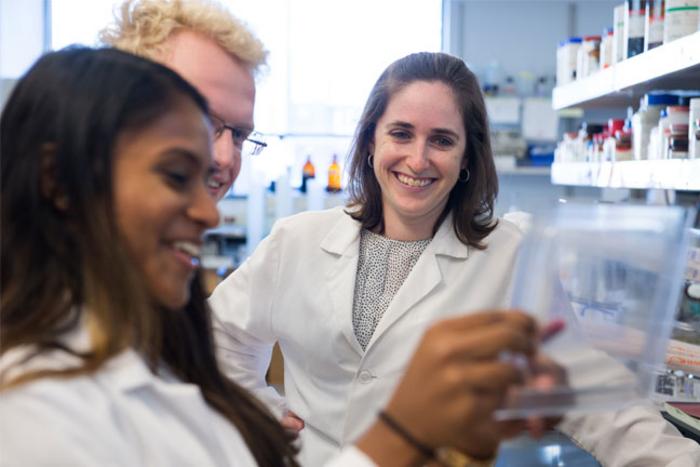Circadian clocks, which drive circadian rhythms, are entwined with many essential systems in living things including plants, fungi, insects, and even humans. Because of this, disruptions to our circadian clocks are linked to higher disease rates in humans, including certain cancers and autoimmune diseases. Rensselaer Polytechnic Institute’s Jennifer Hurley, Ph.D., Richard Baruch M.D. Career Development Chair and Associate Department Head of Biological Sciences, has dedicated her career to understanding the mechanisms that allow our circadian clocks to keep time.

Credit: Rensselaer Polytechnic Institute
Circadian clocks, which drive circadian rhythms, are entwined with many essential systems in living things including plants, fungi, insects, and even humans. Because of this, disruptions to our circadian clocks are linked to higher disease rates in humans, including certain cancers and autoimmune diseases. Rensselaer Polytechnic Institute’s Jennifer Hurley, Ph.D., Richard Baruch M.D. Career Development Chair and Associate Department Head of Biological Sciences, has dedicated her career to understanding the mechanisms that allow our circadian clocks to keep time.
“As proteins are the building blocks of life, it’s important to gain a fundamental understanding of how these proteins work together,” said Hurley. “Knowing how proteins interact can teach us how an organism will behave, and can also give us the opportunity to alter that behavior.”
In research recently published, Hurley and team discovered that the disordered clock protein, FRQ, in a fungus called Neurospora crassa, interacted with a protein called FRH in an unexpected way. They found regions or “blocks” on FRQ that were positively charged. These blocks allowed FRQ and FRH to interact across many different regions.
“While proteins are often thought of as having a well-ordered shape, there is a whole class of proteins that are more flexible, like wet spaghetti noodles” said Hurley. “This flexibility can be important in proteins interactions. In the case of FRQ, we think that its ‘noodliness’ allows the blocks of positive charge to bond to FRH, perhaps like a bear hug.”
“We expected a simple, straightforward interaction between FRQ and FRH,” said Hurley. “And we found the interaction was much more complex than we expected.”
Hurley and team found that this so-called bear hug causes the molecular circadian clock to flip from being an hourglass, which needs to be reset every day by light, to a persistent oscillator, which allows for a continuous rhythm without needing to be reset by light. This persistent circadian oscillator is the fundamental way in which the circadian clock keeps time, regulating anything from our behaviors to how an animal in the Arctic knows when to hunt, even when there is no light available in the winter months.
Each new insight into the mechanisms of our circadian clocks brings us closer to being able to make alterations for great practical benefit. If we could manipulate the circadian clock, it could help in the production of biofuels, in combating jet lag, and in ensuring the health of shift workers and others with irregular schedules.
Health care offers vast opportunities to apply our knowledge of circadian rhythms. “Our field refers to this as ‘chronotherapy,’” said Hurley. “If you get injured at one time of day, you heal much faster than at another. Therefore, we can schedule surgeries at the right time of day. We can even time chemotherapy treatments to when healthy cells are not dividing but cancer cells are, lessoning side effects and increasing treatment efficacy.”
“With this research, Professor Hurley and her team have, once again, advanced our understanding of how circadian rhythms work on a molecular level,” said Curt Breneman, Ph.D., dean of Rensselaer’s School of Science. “This kind of in-depth understanding of the mechanisms of circadian processes opens the door to better mitigation of their effects in higher organisms and humans.”
Hurley was joined in research by Meaghan S. Jankowski, Divya G. Shastry, Jacqueline F. Pelham, Joshua Thomas, and Pankaj Karande of Rensselaer; and Daniel Griffith, Garrett M. Ginell, and Alex S. Holehouse of Washington University School of Medicine.
###
About Rensselaer Polytechnic Institute:
Founded in 1824 for the application of science to the common purposes of life, Rensselaer Polytechnic Institute is the first technological research university in the United States. Today, it is recognized as a premier university, noted for its robust and holistic learning community that connects creativity with science and technology. RPI is dedicated to inventing for the future, from shaping the scientists, engineers, technologists, architects, and entrepreneurs who will define what’s next for humanity, to research that bridges disciplines to solve the world’s toughest problems. Learn more at rpi.edu.
Contact:
Katie Malatino
malatk@rpi.edu
838-240-5691
For general inquiries: newsmedia@rpi.edu
Visit the Rensselaer research and discovery blog:
Follow us on Twitter: @RPINews
Journal
Nature Communications
Article Title
Disordered clock protein interactions and charge blocks turn an hourglass into a persistent circadian oscillator
Article Publication Date
25-Apr-2024



